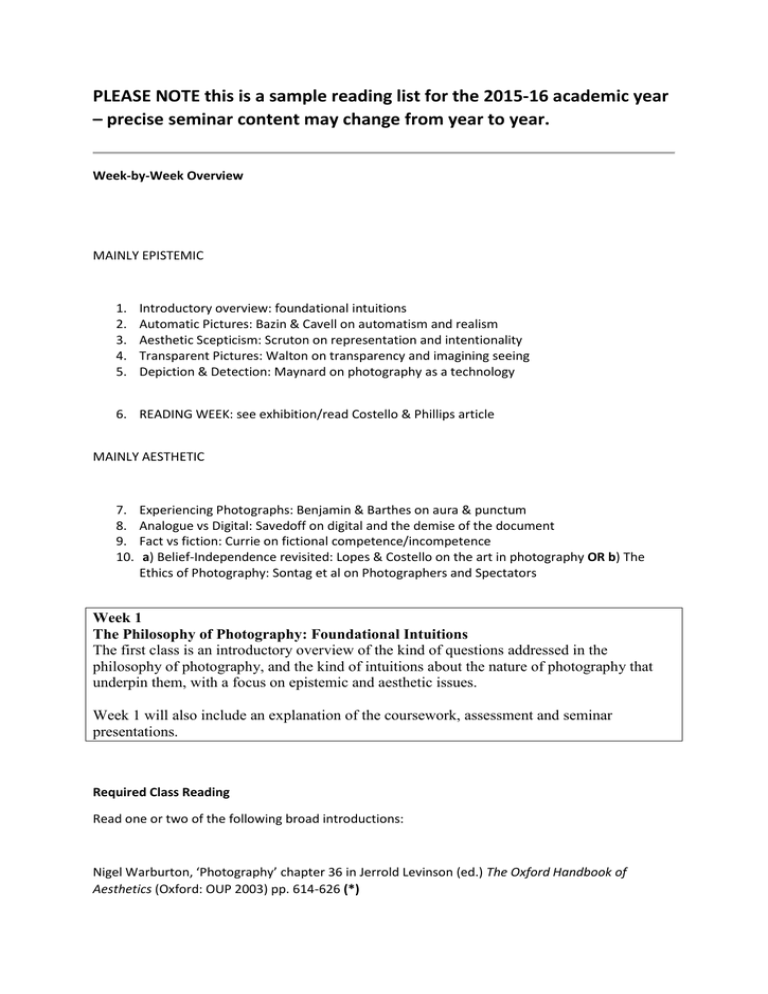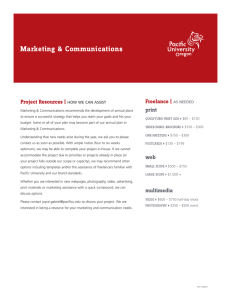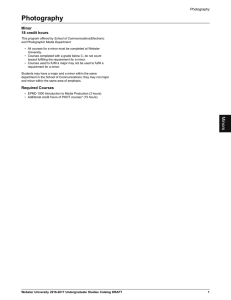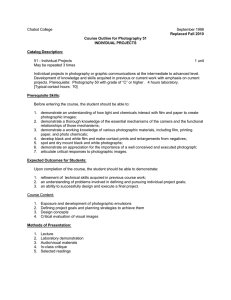PLEASE NOTE this is a sample reading list for the... – precise seminar content may change from year to year.
advertisement

PLEASE NOTE this is a sample reading list for the 2015-16 academic year – precise seminar content may change from year to year. Week-by-Week Overview MAINLY EPISTEMIC 1. 2. 3. 4. 5. Introductory overview: foundational intuitions Automatic Pictures: Bazin & Cavell on automatism and realism Aesthetic Scepticism: Scruton on representation and intentionality Transparent Pictures: Walton on transparency and imagining seeing Depiction & Detection: Maynard on photography as a technology 6. READING WEEK: see exhibition/read Costello & Phillips article MAINLY AESTHETIC 7. 8. 9. 10. Experiencing Photographs: Benjamin & Barthes on aura & punctum Analogue vs Digital: Savedoff on digital and the demise of the document Fact vs fiction: Currie on fictional competence/incompetence a) Belief-Independence revisited: Lopes & Costello on the art in photography OR b) The Ethics of Photography: Sontag et al on Photographers and Spectators Week 1 The Philosophy of Photography: Foundational Intuitions The first class is an introductory overview of the kind of questions addressed in the philosophy of photography, and the kind of intuitions about the nature of photography that underpin them, with a focus on epistemic and aesthetic issues. Week 1 will also include an explanation of the coursework, assessment and seminar presentations. Required Class Reading Read one or two of the following broad introductions: Nigel Warburton, ‘Photography’ chapter 36 in Jerrold Levinson (ed.) The Oxford Handbook of Aesthetics (Oxford: OUP 2003) pp. 614-626 (*) Dawn M Wilson, ‘Photography’ chapter 56 in Gaut and Lopes (eds.) The Routledge Companion to Aesthetics, third edition (London: Routledge 2013) pp. 585-595 (*) Patrick Maynard, ‘Photography’ chapter 40 in Berys Gaut and Dominic McIver Lopes (eds.) The Routledge Companion to Aesthetics (London: Routledge 2001) pp. 477-490 Week 2 Automatic Pictures: Bazin & Cavell on automatism and realism This week examines two foundational intuitions about the specific nature of photography – that is, what distinguishes photography – that recur in various forms throughout the literature: Bazin’s notion of photographic realism, notably the idea of the photograph as a ‘mould of the real’, that retains a mechanically assured connection (even ‘identity’) with its object, and Cavell’s conception of ‘automatism.’ That is, the idea that photographs are essentially the product of an automatic, mechanized, process rather than a product of human intention. Required Class Readings André Bazin, ‘The Ontology of the Photographic Image’ in What is Cinema? Volume 1, University of California, 1971; 9-16 (*) Stanley Cavell, The World Viewed, Revised Edition, Harvard, 1979. Chapters 2-3; pp.16-25. Also Chapter 14, pp. 102-8 (*) The following essays by Bazin and Cavell are also relevant: Bazin, ‘Theatre and Cinema, Part Two’ in What is Cinema? Volume 1, University of California, 1971; pp. 95-124. Stanley Cavell ‘What Photography Calls Thinking’ Raritan, Vol. 4, No. 4, pp. 1-21, reprinted in Poirier (ed) Raritan Reading (Rutgers UP, 1990), 47-65. Relevant Secondary Literature Bazin David Brubaker, ‘Andre Bazin on Auomatically Made Images’ JAAC, 51 1993, 59-67 Jonathan Friday, ‘Andre Bazin’s Ontology of Photographic and Film Imagery’ JAAC 63 (4) Fall 2005: this is a critique of the Currie and Carroll below (*); Greg Currie, Image and Mind: Film, Philosophy and Cognitive Science, CUP 1995 Chapter 2 ‘The Imprint of Nature’ pp.48-78 Noël Carroll, Philosophical Problems of Classical Film Theory (Princeton 1988), chapter 2, pp.94-171 Cavell Joel Synder ‘What Happens by Itself in Photography’ in Ted Cohen, Paul Guyer, and Hilary Putnam (eds.) Pursuits of Reason: Essays in Honour of Stanley Cavell, Lubbock: Texas Tech University Press, 1993. Stephen Mulhall, Stanley Cavell: Philosophy’s Recounting of the Ordinary, Oxford OUP, 1994; pp. 223-230 Espen Hammer, Stanley Cavell: Skepticism, Subjectivity and the Ordinary, Oxford: Polity, 2002 pp. 101-108. Stephen Mulhall ‘Stanley Cavell’ in Diarmuid Costello & Jonathan Vickery (eds.) Art: Key Contemporary Thinkers, Berg 2007 Diarmuid Costello, ‘Automat, Automatic, Automatism: Rosalind Krauss and Stanley Cavell on Photography and the "Photographically Dependent" Arts', Critical Inquiry 38:4. Summer 2012. Diarmuid Costello, ‘But I am killing them!" Reply to Palermo and Baetens on Agency and Automatism', Critical Inquiry 41 (Autumn 2014) Week 3 Aesthetic Scepticism: Scruton on Representation and Intentionality Bazin and Cavell’s view of photography as essentially automatic and causal suggests that photography is a mind-independent process. This raises problems for photography’s status as art, if intentionality, representation or expression are necessary requirements of artistic value. This week we consider Roger Scruton’s argument that there can be no room for such intentionality in photography. As a result, Scruton claims, photographs lack aesthetic interest, making it impossible for photographs to be bona fide artworks. Required Class Reading Roger Scruton ‘Photography and Representation’, in Critical Inquiry 7 (3) 1981, 577-603; and reprinted in Scruton’s The Aesthetic Understanding, Routledge, 1983. (*) Dom Lopes ‘Aesthetics of Photographic Transparency’ Mind 112 (2005) (*) The following essays By Scruton are also relevant: ‘Fantasy, Imagination and Screen’ in The Aesthetic Understanding, Routledge, 1983 ‘The Photographic Surrogate’ in The Philosopher on Dover Beach, Carcanet, 1990 Relevant Secondary Literature Peter Alward, ‘Transparent Representation: Photography and the Art of Casting’ JAAC 70:1 (2012) Dawn Phillips ‘Photography and Causation: Responding to Scruton’s Scepticism’ in the British Journal of Aesthetics Vol. 49 No.4, October 2009 William King, ‘Scruton and Reasons for Looking at Photography,’ BJA 32 (3), 258-65 [reprinted in Neill & Ridley eds. Arguing about Art (second ed. only)]. Robert Wicks, ‘Photography as a Representational Art’ BJA 29 (1) 1989 1-9 Nigel Warburton, ‘Varieties of photographic representation,’ History of Photography 15 (3) Autumn 1991, 203-10 Nigel Warburton, ‘Individual Style in Photographic Art’ BJA 36 (4) 1996, 389-97 [reprinted in Neill & Ridley eds. Arguing about Art (second ed. only)]. Berys Gaut ‘Cinematic Art’ JAAC, 60, 299-312. David Davies ‘How Photographs “Signify:” Cartier-Bresson’s “Reply” to Scruton’ in Scott Walden (ed.) Photography and Philosophy: Essays on the Pencil of Nature, Blackwell 2008. Jonathan Friday, Aesthetics of Photography, Ashgate 2002 [chapt 4] Week 4 Transparent Pictures: Walton on Transparency and ‘Imagining Seeing’ Scruton claimed that viewing a photograph is merely a surrogate for viewing the object photographed. Relatedly, Kendall Walton claims photographs are ‘transparent’ to their objects. That is, we indirectly but nonetheless literally see the photographed objects when we look through a photograph. Time permitting, we will also consider what it means to say that we imagine seeing it directly. If Walton is right and photographs are transparent, what are the aesthetic implications? Unlike Scruton, Walton does not take his account to deny the possibility of photographic art. Required Class Reading Kendall Walton: ‘Transparent Pictures: On the Nature of Photographic Realism’ Critical Inquiry, 11 (Dec 1984); 246-77; a version of this paper was also published in Noûs, Vol. 18, No. 1, 1984, pp. 6772. (*) An updated version of this essay appears in Marvelous Images: On Values and the Arts OUP 2008 pp.79-109 plus the additional ‘Postscripts to Transparent Pictures,’ pp. 110-116, only available in this volume. (*) For an overview of Walton’s theory of make-believe see ‘Pictures and Hobby Horses’ also in this volume, pp. 63-78. (*) The following by Walton, often in reply to his critics, are also relevant: Walton ‘Looking Again through Photographs: A Response to Edwin Martin’ Critical Inquiry 12, 80110. Walton, ‘On Pictures and Photographs: Objections Answered’ in R. Allen and M. Smith (eds.) Film Theory and Philosophy, OUP, 60-75. Reprinted in Marvelous Images: On Values and the Arts, OUP 2008 pp.117-132 (extract*) Walton, Mimesis as Make-Believe Harvard University Press 1990 Relevant Secondary Literature Edwin Martin ‘On Seeing Walton’s Great-Grandfather’ Critical Inquiry 12, 796-800. Patrick Maynard ‘The Secular Icon’ JAAC, 42 (1983), 155-170. Patrick Maynard ‘Seeing Double’ JAAC 52.2 (Spring 1994): 156-167 Warburton, ‘Seeing through ‘Seeing through Photographs’’ Ratio 1 (June 1988) 62-74 Greg Currie, ‘Photography, Painting and Perception,’ JAAC 49 (1991) 23-9 Noël Carroll, ‘Defining the Moving Image’, Theorizing the Moving Image OUP, 1996 Greg Currie, Image and Mind: Film, Philosophy and Cognitive Science, CUP 1995, Chapter 2 ‘The Imprint of Nature’ pp.48-78 Jonathan Friday, ‘Transparency and the Photographic Image’ BJA 36:1, 1996, 30-42 Scott Walden ‘Objectivity in Photography’ BJA 2005 45(3): 258-272 Dom Lopes Understanding Pictures, OUP 1996 Chapter 9, pp.174-196 Amy Kind ‘What’s So Transparent about Transparency?’ Philosophical Studies 115 (2003) 225-244 Cynthia Freeland ‘Photographs and Icons’ in Walden, Photography and Philosophy Jonathan Friday, Aesthetics of Photography, Ashgate 2002 (chapt 3) Diarmuid Costello, ‘The Question Concerning Photography’ JAAC 70:1 (2012) Supplementary Reading the debate over ‘epistemic privilege’ Jonathan Cohen and Aaron Meskin ‘On the Epistemic Value of Photographs’ JAAC 62 (2004) 197-210 Jonathan Cohen and Aaron Meskin ‘Photographs as Evidence’, in S. Walden (ed.) Photography and Philosophy: Essays on the Pencil of Nature Routledge, 2008. On line: http://www.hps.leeds.ac.uk/Staff/AME/agnosticism.pdf and http://aardvark.ucsd.edu/perception/agnosticism.pdf. Scott Walden ‘Truth in Photography’ in Scott Walden (ed.) Photography and Philosophy: essays on the Pencil of Nature, Blackwell 2008. Scott Walden, Photography and Knowledge, JAAC 70:1 (2012) Week 5 Depiction and Detection: Maynard on Photography as a Technology For Maynard, who builds upon Walton’s conception of ‘imagining seeing’, photography is conceived as a tool with various functions -- notably depiction and detection. This approach, by focusing on photography as a technology, generates a conception of photography that foregrounds its multiple uses. It asks not what a photograph, as an object, is but what photography, as an activity, does. Is this a more productive approach to photography’s various uses? Required Reading Patrick Maynard, ‘Photography as Technology’ chapter 1 of The Engine of Visualisation, Cornell 1997 (*). Plus chapters IV ‘Imagining Technologies’ and VII ‘Photo Fidelities I: Photographic Seeing’. (extracts*) Other Relevant Essays by Maynard include: Maynard ‘The Secular Icon: Photography and the Function of Images’ JAAC, 42 (1983), 155-170. Maynard ‘Drawing and Shooting: Causality in Depiction’ JAAC 44 115-29 Maynard ‘Talbot’s Technologies: Photography and the Functions of Images’ JAAC 47 263-76 Maynard ‘Photo-opportunity: Photography as Technology’ Canadian Review of American Studies 22 501-28 Relevant Secondary Literature Laura Perini, Depiction, Detection, and the Epistemic Value, JAAC 70:1 (2012) Week 6: READING WEEK NO CLASS 1. For a critical overview of the material covered so far, read Diarmuid Costello & Dawn M. Phillips ‘Automatism, Causality and Realism: Foundational Problems in the Philosophy of Photography, Philosophy Compass 4/1 (2009): pp.1-21 (*) 2. Also see one significant photography exhibition. Details to be supplied. Week 7 Experiencing Photographs: Benjamin and Barthes on aura and punctum This week we focus on our experience of photographs. Why, for example, do we have such strong psychological investments in photographs of dead or absent loved ones? Some of these themes pick up refrains from Bazin about the photograph’s ‘identity’ with what it depicts. Barthes in particular focuses on photography’s relation to death and its ability to ‘pierce’ us in ways that other images cannot. In doing so he picks up a theme from Benjamin concerning photography’s relation to the real. These two writers have been hugely influential on the literature on photography in art theory and continental aesthetics. Required Class Reading Walter Benjamin ‘A Small [Little] History of Photography’ in One Way Street, Verso, 1979, and in Selected Writings Harvard Vol. 2, part 2, Harvard, 1999 (*) Roland Barthes Camera Lucida, Fontana, 1981; you are encouraged to read the whole text, but see especially §§10-11, 17-20, 22-3, 32-6, 39, 45-6 (*) Other essays by Benjamin and Barthes that are relevant include: Benjamin, ‘The Work of Art in the Age of its Technical Reproducibility’ [aka The Work of Art in the Age of Mechanical Reproduction’] in Illuminations, Schocken 1968, and Selected Writings, Vol. 4, Harvard 2003; especially §§II-IV, VI. See: http://www.marxists.org/reference/subject/philosophy/works/ge/benjamin.htm Benjamin ‘On Some Motifs in Baudelaire’ in Illuminations, Schocken 1968, and Selected Writings, Vol. 4, Harvard 2003; §XI Barthes, ‘The Photographic Message’ and ‘the Rhetoric of the Image’ in Roland Barthes, Image, Music, Text, Fontana 1977. Secondary Literature Barthes Michael Fried ‘Barthes’s Punctum’, Critical Inquiry 31 (Spring 2005): 539-74 James Elkins ‘What Do We Want Photography To Be?: A Response to Michael Fried, Critical Inquiry, Vol. 31. No. 4, Summer 2005. Margaret Iversen ‘What is a Photograph?’ Art History 17: 3, Sept 1994, 450-463 Margaret Olin, ‘Touching Photographs: Roland Barthes’s ‘Mistaken Identification’ Representations 80 (Fall 2002), 99-118. Geoffrey Batchen (ed.) Photography Degree Zero: Reflections on Camera Lucida, MIT 2009. Susan Sontag On Photography, Fontana 1977 Nancy Shawcross ‘Roland Barthes,’ in Diarmuid Costello & Jonathan Vickery (eds.) Art: Key Contemporary Thinkers, Berg 2007 Benjamin Diarmuid Costello ‘Aura, Face, Photography: Re-Reading Benjamin Today, in A. Benjamin (ed.) Walter Benjamin and Art, London: Continuum, 2005; pp. 164-184 Robert Kaufman “Aura, Still,” October 99 (Winter 2002): 45-80, reprinted in Walter Benjamin and Art, as above 121-147 Joel Snyder ‘Benjamin on Reproducibility and Aura’ in Gary Smith (ed.) Benjamin: Philosophy, Aesthetics, History, Chicago 1989 Rodolphe Gasché, ‘Objective Diversions: On Some Kantian Themes in Walter Benjamin’s …’ in A. Benjamin and P. Osborne (eds) Walter Benjamin’s Philosophy: Destruction and Experience, Manchester: Clinamen Press, 2000, pp. 180-201. Helmut Schmitz ‘Walter Benjamin,’ in Diarmuid Costello & Jonathan Vickery (eds.) Art: Key Contemporary Thinkers, Berg 2007 Supplementary Literature On the reception of Benjamin in art theory, see Jeannene M. Przyblyski, ‘History is photography: the afterimage of Walter Benjamin’, Afterimage, Sept-Oct, 1998. Week 8 Analogue vs Digital: Savedoff on digital and the demise of the document In recent years the emergence of digital photography has posed challenges to traditional conceptions of photography, particularly the idea of its mind-independent relation to the world. We will critically examine the notions that there is an essential difference (a difference of kind rather than degree) between analogue and digital photography and that these might represent distinct media for art, with implications for the unity of photographic ontology. Required reading Barbara Savedoff, Transforming Images: How Photography Complicates the Picture, Cornell, 2000; chapter 5 (*). Barbara Savedoff ‘Escaping Reality: Digital Imagery and the Resources of Photography’ JAAC 55 20114 (*) Secondary Reading: John Zeimbekis, Digital Pictures, Sampling, and Vagueness: The Ontology of Digital Pictures JAAC 70:1 (2012) Bence Nanay, The Macro and the Micro: Andreas Gursky’s Aesthetics, JAAC 70:1 (2012) Christy Mag Uidhir, Photographic Art: An Ontology Fit to Print JAAC 70:1 (2012) Supplementary Reading: Jonathan Friday, ‘Digital Imaging, Photographic Representation and Aesthetics’ and Nigel Warburton, ‘Pixels and Pictorialism: A Reply to Jonathan Friday’, in ‘Ends and Means’ vol 1 no 2, and vol 2 no 2. (*) There is also a substantial literature on digitalization in art theory: William Mitchell Reconfigured Eye: Visual Truth in the Post-Photographic Era, MIT 1998, Chapter 3 ‘Intention and Artifice’ pp. 23-58 Lev Manovich ‘Paradoxes of Digital Photography’ in H. Amelunxen, S. Iglhaut, F. Rötzer (eds.) Photography after Photography: Memory and Representation in the Digital Age, G+B Arts, 1996; reprinted in Liz Wells (ed.) Photography Reader, Routledge 2003 Martin Lister, Photographic Image in Digital Culture, Routledge, 1995 (extracts are reprinted in Liz Wells Photography Reader, Routledge 2003.) See also the other essays collected in Liz Wells (ed) Photography Reader, Routledge, 2003; Part V ‘photo-digital.’ See the essays collected in H. Amelunxen, S. Iglhaut, F. Rötzer (eds.) Photography after Photography: Memory and Representation in the Digital Age, G+B Arts, 1996. Geoffrey Batchen ‘Ectoplasm: Photography in the Digital Age’ in Carol Squiers (ed.) Over Exposed: Essays on Contemporary Photography, New York Press 2000 Week 9 Fact and Fiction: Currie on fictional competence and incompetence Insofar as photographs have a privileged epistemic status (objectivity, realism, fidelity etc.) it may seem that they are factual. Scruton, for example, argued that photographs are fictionally incompetent. We will discuss the extent to which photographs may be fictional as well as factual, and consider why critics have argued that this is essential if photography is to be considered a medium for art. Required reading Gregory Currie ‘Visible Traces: Documentary and the Contents of Photographs’ JAAC 57:3 (1999) pp.285-297 (*) Gregory Currie, ‘Pictures of King Arthur: Photography and the Power of Narrative’ in Walden (ed.) Philosophy and Photography: Essays on the Pencil of Nature. (*) Secondary Reading: Paloma Atencia-Linares ‘Fiction, Non-Fiction, and Deceptive Photographic Representation,’ JAAC 70:1 (2012) Dawn Phillips ‘Photography and Causation: Responding to Scruton’s Scepticism’ in the British Journal of Aesthetics Vol. 49 No.4, October 2009 Dan Cavedon-Taylor ‘In Defence of Fictional Incompetence’, Ratio 23:2, pp. 141-150, June 2010 Week 10 TBC: possibility 1 Belief-independence revisited: Costello and Lopes on the art in photography We conclude by considering the prospects for, and upshots of, rethinking the mind or beliefindependence of photography and photographic imaging. Given the difficulties that this starting point presents for thinking about non-automatic uses of the medium, in particular artistic uses of the medium, we consider whether photographs can be distinguished from other means of depicting the world, preserving what’s special about photography, but without thereby reducing photography to what distinguishes it. Call this a benign, non-prescriptive notion of ‘medium specificity.’ Required reading Dominic McIver Lopes ‘We’re All Artists Now’ (‘Jetzt sind wir alle Künstler’ in Julian NidaRümelin und Jakob Steinbrenner (eds.) Kunst und Philosophie: Fotografie zwischen Inszenierung und Dokumentation, Hatje Cantz Verlag, 2012) (*) Diarmuid Costello & Dom Lopes, ‘Photographic Intelligence: Experiment and Expression in James Welling’ (unpublished draft, available on request) (*) The following essays by Lopes and Costello are also relevant:— Diarmuid Costello, ‘The Question Concerning Photography,’ JAAC 70:1 (Winter 2012) Diarmuid Costello, ‘But I am killing them!" Reply to Palermo and Baetens on Agency and Automatism', Critical Inquiry 41 (Autumn 2014) Dominic McIver Lopes, ‘Four Arts of Photography’, forthcoming book. Dominic McIver Lopes Understanding Pictures, OUP, 2004, chapter 9: §§9.3-9.6 Secondary Reading: Ted Cohen, ‘What’s Special about Photography?’ The Monist 71 (1988) 292-305 Week 10 TBC: possibility 2 Ethics of Photography: Sontag et al on Photographers and Spectators Each of the many uses of photography raises its own moral considerations. Given what has been said about the arguably privileged epistemic status of photography in virtue of the nonintentional nature of the causal process, this raises particular moral considerations about photography’s employment for artistic ends, both for the role of the photographer and the spectator. There are various topics we might consider here: photojournalism, feminism, pornography, portraiture and the ethical implications of digital manipulation, for example in photojournalism as opposed to photographic artworks. Required Reading Susan Sontag On Photography, Penguin 1977 ‘In Plato’s Cave’ pp.3-24 (*) Jonathan Friday, ‘Demonic Curiosity and the Aesthetics of Photography’ BJA 40 (3), July 2000. (*) Nigel Warburton ‘Ethical Photojournalism in the Age of the Electronic Darkroom’ in M Kieran (ed.), Media Ethics, Routledge, 1998 Relevant Secondary Literature Arthur Danto ‘The Naked Truth’ in J. Levinson (ed.) Ethics and Aesthetics, Cambridge: CUP, 1998. Scott Walden ‘Ethical Art’ (contribution to an online symposium on Danto: http://www.vanderbilt.edu/AnS/philosophy/events/.OCA/WaldenDantoConference.pdf (available on request) Stephanie Ross ‘What Photographs can’t do’ Journal of Aesthetics and Art Criticism 41:1, 1982, pp.517 (*) See the essays collected in Part VI of Liz Wells (ed.) Photography Reader, Routledge 2003 as ‘Documentary and Photojournalism’, Nigel Warburton ‘Photographic Communication’ BJA 28 (1988) 173-181 Supplementary Reading Roland Barthes ‘Shock Photos’ in The Eiffel Tower and Other Mythologies (trans. Richard Howard) University of California Press, 1979, pp.71-73.







